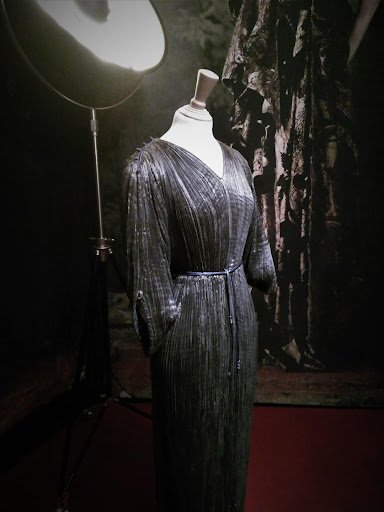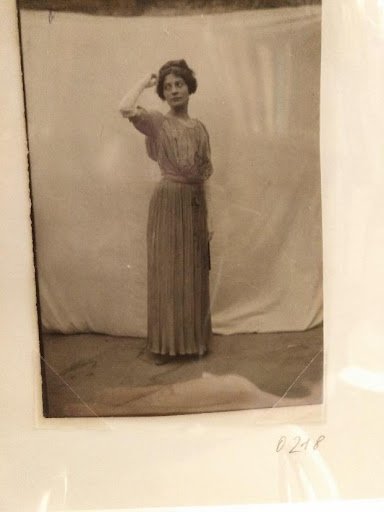Mariano and Henriette Fortuny: Notes on Co-Creating the Delphos Gown
“The Fortuny gown which Albertine was wearing that evening seemed to me the tempting phantom of that invisible Venice”
The Delphos gown—unusual and evocative—and its creators Mariano and Henriette Fortuny are so significant in the history of fashion that they were canonized in literature during the height of the gown’s popularity, as shown in the above quote.
Mariano Fortuny y Madrazo was the son of Mariano Fortuny y Marsal and Cecilia de Madrazo who were both involved in artistic social circles. After his father's death, when Mariano was three, the family moved to Paris, where he spent his formative years close to his uncle and another Spanish painter, Rogelio de Egusquiza; there, he met Henriette. Though they met in Paris, Mariano and Henriette began their relationship in Venice and established a residence in Palazzo Pesaro degli Orefi.
An artist, painter, and photographer, one might go so far as to call Fortuny a ‘Renaissance man.’ He created his own machines for the fabrication of garments, developed his own technique to print textiles, and he worked in lighting and scenography. [1] Fortuny’s interests were interconnected as well; the Delphos gown can be seen in his paintings and photographs.
But we cannot give credit to Fortuny alone for his work with textiles and garments. Henriette Negrin is often referred to as Fortuny’s “muse” due to her frequent appearances ain his paintings and photographs, but her active role as co-designer is not as well known. [2] This paper seeks to establish Negrin as Fortuny’s co-designer and co-creator of the Delphos gown. [3]
The Delphos gown was created in 1909 when its patent was registered with the Office National de la Propriété Industrielle in Paris.
“This invention refers to a type of garment that is derived from the classical robe, but designed in such shape and with such mechanism as to permit easy use and comfortable adjustment…The dress consists of a robe, open both at the top and at the bottom, whose width can be equal to its length, widening or narrowing from top to bottom or at various points, in accordance with the general appearance and aspect one desires to give to the dress. The fabric can be smooth or pleated; this detail is an independent invention.
“The upper section is laid flat so that the two edges are level and these are then fastened at points d and e in whatever way one decides; an opening in the centre forms the neckline, two lateral openings c c are for arms through with, in between, two openings b b whose edges are laced together. Between the lateral points e and g strings are attached obliquely to adjust and modify distance x which determines the bottom of the sleeve in accordance with the size and height of whoever is wearing the dress. These strings are on the inside of the dress so as to be invisible.” [4]
Illustration of the Delphos gown patent. Founded in : Brevet D’Invention, genre de vêtements pour femmes, Office National de la Propiété Industrielle, 10 June 1909. M.8.1.5. Il Fondo Mariutti Fortuny, Biblioteca Nazionale Marciana, Venice. Photo taken by Alba Sanz Álvarez
Alongside the patented pleating, this registration confirms the consistency of the Delphos design. Most interestingly, there is a handwritten note by Mariano Fortuny in the registered patent that states, “This patent is owned by Mrs. Henriette Brassart who is the inventor. I enclosed this patent on my name/behalf due to the urgency of the deposit…in Paris June 10, 1909.” [5] He indicates with these words that Henriette is in fact the creator. Despite this, she is more likely to be referred to as inspiration or a collaborator rather than as the designer or co-creator of the gown.
This may be because the Delphos gown stopped being produced when Mariano Fortuny died in 1949. However, Henriette wrote in a letter to Elsie McNeill:
“[…] Regarding Delphos, after mature consideration – and this is why I have been slow to answer – I have irrevocably decided to cease all commercial production. Similarly, given that these garments are of my own creation, even more than many other, I desire that no-one else take them over, and thus to the sale of the Delphos we must apply the words the end.” [6]
Not only do these archival pieces support her co-creation of the Delphos gown, but further analysis of photographs reinforce this speculation.
Fortuny, Mariano. Henriette wearing a prototype of the Delphos gown, 1909. Scatola A, F.3, 0218. Il fondo Mariutti Fortuny, Biblioteca Nazionale Marciana, Venice.
This photograph dated 1909—the same year as the patent—shows Henriette wearing a dress similar to the Delphos. The title of the archive summary confirms that it was a prototype. The white sheet in the background of the photo indicates that she is in a studio and various poses allow us to assume that the viewer is analyzing the dress from different perspectives for design purposes. A private or personal photo would not share these aspects.
While one might note that Henriette is only modeling in this photo, this should not invalidate her influence and agency in the creative process of the gown. On the contrary, the wearer of the gown is given great importance in the creative process. Her insight on how to wear this dress is similar to feedback that a wearer would provide. [7] She was able to provide her own experience wearing the garment in the creative process. Her and Fortuny’s joint experiences in the creation process—she as the model and he as the photographer—allowed them both to examine, analyze, and improve the garment on the wearer to the desired result.
We are aware of a similar relationship between Charles Frederick Worth and his wife, Marie Vernet. Worth was one of the first designers to show dresses on living models. His wife became his star and, after she had stopped modeling, she trained Worth’s models. [8] While it is not known if Vernet’s role as a model influenced Worth’s designs and creative process, she had an active role in promoting the business.
Another aspect of this photo worth considering is the styling of the garment. Henriette is wearing gloves, which usually adorned evening gowns. [9] However, the Delphos gown is believed to have been developed as a tea gown, to be worn in the late afternoon. [10] This differentiation is relevant because the tea gown was reserved for the home as opposed to the evening gown; including the gloves in the photograph could change our idea of the gown’s original purpose. Mariano and Henriette may have imagined the Delphos as an evening gown rather than a tea gown so that it may be worn in public rather than within the home.
Fortuny, Mariano. Henriette wearing a prototype of the Delphos gown, 1909. Scatola A, F.3, 0198. Il fondo Mariutti Fortuny, Biblioteca Nazionale Marciana, Venice.
These archival pieces led me to reconsider the role of Henriette Fortuny beyond her portrayal as her husband’s muse. Despite multiple references to her activity in the fashion industry at the time, her charge of their workshop in Palacio Pesaro degli Orfei, and Fortuny’s own admission that she is the creator of the Delphos gown in the patent registration, she is almost universally overlooked. Though she was the one who collected and preserved all the documents and material related to the Fortunys’ work, information about her alone is lacking. Henriette’s importance often goes unnoticed, which emphasizes how frequently women are ignored in history.
Walter Benjamin stated that “history is the object of a construction whose place is formed not in a homogenous empty time, but in that which is fulfilled by the here-and-now.” [11] In a history of ‘winners,’ there is also a history of the forgotten. Women such as Henriette often fall into the latter category. With this short essay, I wanted to contribute to emphasizing Henriette’s active role and participation in garment production, specifically of the Delphos, jointly with her husband and show them as an eminent example of collaboration in garment and textile creation.
Notes
[1] Biographical data extracted from the first chapter in Guillermo de Osma, Mariano Fortuny. His life and work (London: V&A Publishing, 2015), 10-38.
[2] Biographical details about Henriette found in Daniela Ferreti, ed., Henriette Fortuny: Portrait of a Muse (Venice: Fondazione Musei civici, 2015)
[3] In the preparation of this essay and revising literature on the topic, I found out that shortly after I finished my Master thesis investigation, the same year -2017-, a paper was published claiming the role of Henriette as the creator of the Delphos by Silvia Bañares. My essay is based on my own investigation, findings and conclusion about the Delphos gown. Here is the reference to the mentioned article: Silvia Bañares, “A Short Biographical Note on Henriette Nigrin, Creator of Delphos”, Datatèxtil 36 (2017), 73–84.
[4] Brevet D’Invention, genre d’étoffe plissée-ondulée, Office National de la Propiété Industrielle, 10 June 1909, M.8.1.5, Il Fondo Mariutti Fortuny, Biblioteca Nazionale Marciana, Venice. Translation by Guillermo de Osma from the original in French in: Guillermo de Osma, Mariano Fortuny, 145-46.
[5] Brevet D’Invention, genre d’étoffe plissée-ondulée, Office National de la Propiété Industrielle, 10 June 1909, M.8.1.5, Il Fondo Mariutti Fortuny, Biblioteca Nazionale Marciana, Venice. Quoted and transcribed in Ferreti, Henriette Fortuny, 89. Referred also in Wendy Ligon Smith, “Reviving Fortuny's Phantasmagorias,” (PhD diss., The University of Manchester, 2015), 100, https://www.escholar.manchester.ac.uk/api/datastream?publicationPid=uk-ac-man-scw:263682&datastreamId=FULL-TEXT.PDF.
[6] Transcribed letter from Henriette Fortuny to Elsie MacNeill quoted in Ferreti, Henriette Fortuny, 90.
[7] Brevet D’Invention, genre d’étoffe plissée-ondulée, Office National de la Propiété Industrielle, 10 June 1909, M.8.1.5, Il Fondo Mariutti Fortuny, Biblioteca Nazionale Marciana, Venice. Translation by Guillermo de Osma from the original in French in: Guillermo de Osma, Mariano Fortuny, 145-46.
[8] Valerie Steele, ed., The Berg Companion to Fashion (Oxford: Berg, 2000), 297-298.
[9] Evening Drees: “Simply put, evening dress is the prevailing style prescribed by fashion to be worn in the evening. Though straightforward in its basic definition, there are surprisingly complex expectations related to appropriateness of fashionable dress for evening. (…) an evening gown is a special form of dress that amplifies a woman’s femininity and often proclaims her desirability. Evening dress materialize as a category in the mid-1820s.” Definition extracted from Valerie Steele, Encyclopedia of clothing and fashion. Vol. 1, Academic dress to eyeglasses (Detroit, Mich.: Thomson Gale, 2005), 438-429.
[10] Valerie Steele, Encyclopedia of clothing and fashion. Vol. 3, Occult dress to Zoran (Detroit, Mich.: Thomson Gale, 2005), 271-272.
[11] Walter Benjamin, “Theses on the Philosophy of History,” in Illuminations, ed. Hannah Arendt (New York: Schocken Books, 1969), 261.





